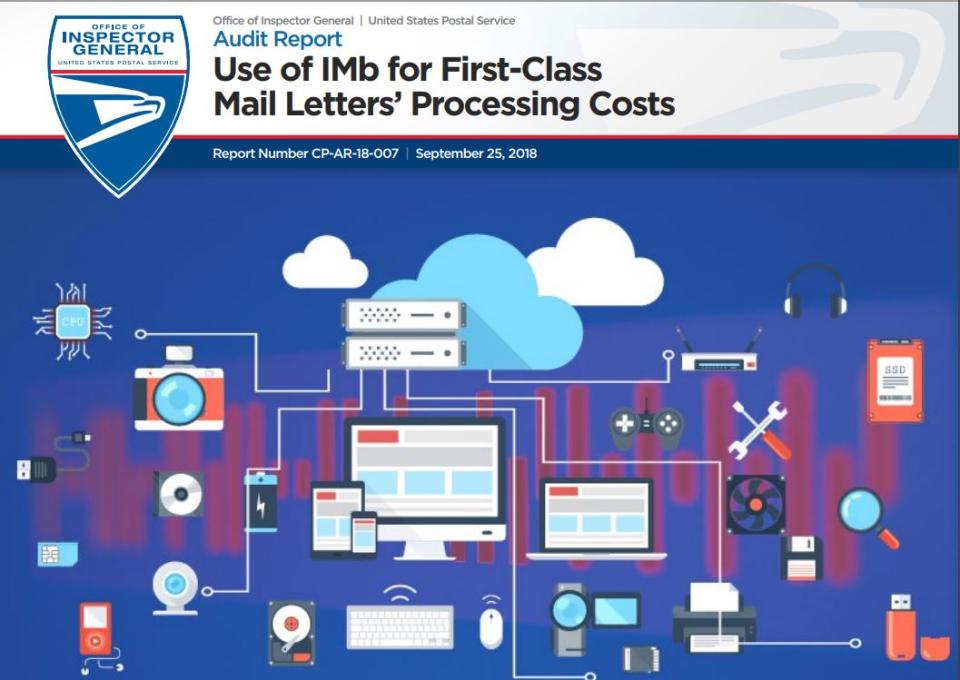Use of IMb for First-Class Mail Letters’ Processing Costs
Objective
The Postal Service implemented use of Intelligent Mail barcodes (IMb) in September 2006, to sort and track individual letters, cards, and flats. The technology offers greater versatility by allowing many services to be requested and embedded in one barcode. The Postal Service obtains reports related to IMb data from various systems, including its data analytics platform, the Informed Visibility (IV) system. The system provides data and analytics to external and internal customers to enable greater visibility of mailpieces.
The Postal Service has made efforts to leverage IMb data in costing. In July 2017, the Postal Service petitioned the Postal Regulatory Commission (PRC) to update the transportation cost model for Parcel Select/Parcel Return Service mail based on new information obtained from IMb data. The PRC approved the change in November 2017, stating the change should improve the quality and accuracy of the cost estimates.
Our objective was to assess whether the Postal Service can leverage IMb data in the IV system to enhance the accuracy and reliability of mail processing costs for First-Class Mail letters.
What the OIG Found
Although the Postal Service has explored uses of IMb data in costing, opportunities exist to further leverage IMb and other mailpiece data in the IV system to improve the accuracy and reliability of cost estimates for First-Class Mail letters. Specifically:
- IMb and IV technologies could strengthen data collection and analysis for costing, cost modeling, and cost attribution. However, the Postal Service has not fully leveraged these technologies since implementation. It did not have a strategic plan or timeline to evaluate how IMb and IV could support more efficient costing procedures and increase visibility of product costs. Management stated IMb and IV are operational technologies that are not currently designed to capture data for costing; therefore, they have not developed a plan to use IMb data for costing strategies. IMb scan data is also not readily accessible to costing personnel in a useable format within the IV system.
- Mailing industry representatives stated that IMb, when first introduced, was marketed as a technology that would create operational efficiencies, increase mailpiece visibility, and provide new data points that could be used to improve costing. In addition, the Postal Service’s business case for IMb stated it would provide enhanced data analytics and end-to-end mailpiece visibility to support costing strategies and product pricing. Further, the business case for IV stated the Postal Service planned to use IV to drive cost savings and optimize financial performance, among other things.
- The Postal Service could enhance the accuracy and reliability of mail processing unit cost estimates for First-Class Mail letters by leveraging IMb data from IV. The First-Class Mail letters cost model does not precisely capture the costs of certain mail processing activities. During site visits, we identified the following nonstandard or unexpected mail flows for First-Class Mail letters that resulted in alternative or additional processing steps.
- Plant personnel sometimes run letters on flats mail processing equipment (MPE). This allows personnel to process more letter mail when letters are too large or thick to run on letter MPE, letter machines are already at capacity, or flats machines are idle.
- The same letters are sometimes processed multiple times under the same operation on MPE. This can occur due to equipment failures, incorrect tray labels, improper handling of forwarded mail, or incorrect mailpiece barcodes or Zone Improvement Plan (ZIP) Codes.
- Plant personnel do not always run automation letters on MPE. Consequently, these letters skip the mail processing steps they are expected to receive. This can occur because personnel may not have time to process all letters on MPE before the mail needs to leave the plant to meet service performance goals.
The cost model does not precisely capture or explicitly model the costs of these mail flows because these nonstandard operational activities should not be occurring. Leveraging IMb data from IV could enhance the accuracy and reliability of mail processing cost estimates by capturing these nonstandard activities.
Management stated they apply an adjustment factor to capture mail processing costs for mail flows not explicitly modeled. This adjustment is applied evenly to all model mail product categories. However, we believe these costs may affect each price category differently, depending on which categories are likely to follow nonstandard mail flows. Applying an evenly distributed adjustment factor across all categories in the model may distort actual costs incurred by individual mail product categories.
The Postal Service and PRC rely on accurate and reliable cost estimates to make informed operational and pricing decisions. Precise cost estimates support improved price setting decisions that ensure prices comply with the law and cover actual costs incurred. IMb and IV could potentially provide a clearer understanding of cost drivers at the product level by increasing visibility and granularity of cost information. These opportunities could reduce the need for less efficient and more costly data collection and statistical sampling.
What the OIG Recommended
We recommended management:
- Develop a strategic plan to assess how IMb and IV technologies can be used to support costing and, based on the assessment, determine how and when the technologies can be used to improve costing.
- Create and provide access to detailed IMb data reports or dashboards in IV for use by costing personnel.
- Use IMb and IV technologies to assess the impact of unexpected or nonstandard mail flows on First-Class Mail letter cost model estimates and, based on the evaluation, consider filing a petition with the PRC to use IMb and IV data to update the model.

